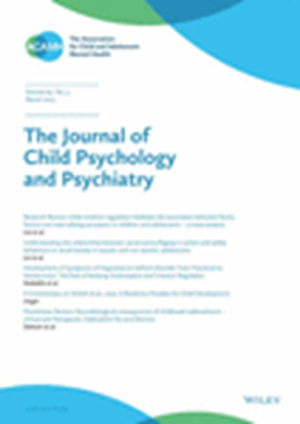前瞻性、纵向、基于人群的早产和足月出生青壮年队列中的脑组织微观结构
IF 6.5
1区 医学
Q1 PSYCHIATRY
引用次数: 0
摘要
背景每年有 1500 万婴儿早产,这使他们面临终生不良神经发育后果的高风险。早产儿伴随的脑组织异常是否会持续到成年后,并与长期的认知或精神发育结果相关,目前尚不清楚。方法我们对连续确定的早产儿及其匹配的足月对照进行了从婴儿期到成年后的人口抽样调查。早产儿组的平均胎龄为 31.5 ± 2.6 周。我们获得了弥散张量成像扫描结果,并对平均年龄为 19 岁(17.6-20.8 岁)的早产儿成年后的认知能力和精神状况进行了评估。结果早产与内囊深层白质束、脑梗、额下-枕束、矢状层和胼胝体脾以及尾状核、丘脑和丘脑灰质的分数各向异性(FA)较低和平均扩散系数(ADC)较高有关。胎龄越小,这些组织异常越明显。围产期特征,包括较低的5分钟APGAR评分、支气管肺发育不良病史、较多的补氧天数和多胎分娩,都会增加大脑深部白质束和灰质的ADC值。早产儿的全面智商明显较低,一生中患精神疾病的次数也更多。结论与早产有关的脑组织微观结构异常一直持续到青年期,很可能代表着髓鞘化紊乱和伴随的轴突病变。这些紊乱与成年后罹患精神疾病的可能性较高有关。早产儿和围产期出现感染和炎症并发症的婴儿的脑组织障碍更为严重。本文章由计算机程序翻译,如有差异,请以英文原文为准。
Brain tissue microstructure in a prospective, longitudinal, population‐based cohort of preterm and term‐born young adults
BackgroundFifteen million infants annually are born prematurely, placing them at high risk for life‐long adverse neurodevelopmental outcomes. Whether brain tissue abnormalities that accompany preterm birth persist into young adulthood and are associated with long‐term cognitive or psychiatric outcomes is not known.MethodsFrom infancy into young adulthood, we followed a population‐based sample of consecutively identified preterm infants and their matched term controls. The preterm group was born at an average gestational age of 31.5 ± 2.6 weeks. We obtained Diffusion Tensor Imaging scans and assessed cognitive and psychiatric outcomes in young adulthood, at a mean age of 19 (range 17.6–20.8) years. Usable data were acquired from 180 participants (89 preterm, 91 term).ResultsPreterm birth was associated with lower fractional anisotropy (FA) and higher average diffusion coefficient (ADC) values in deep white matter tracts of the internal capsule, cerebral peduncles, inferior frontal‐occipital fasciculus, sagittal stratum and splenium of the corpus callosum, as well as in grey matter of the caudate, putamen and thalamus. A younger gestational age at birth accentuated these tissue abnormalities. Perinatal characteristics, including lower 5‐min APGAR score, history of bronchopulmonary dysplasia, more days of oxygen supplementation and multiple births all increased ADC values in deep white matter tracts and grey matter throughout the brain. Preterm individuals had significantly lower full‐scale IQ and more frequent lifetime psychiatric disorders. Those with psychiatric illnesses had significantly higher ADC and lower FA values throughout the deep posterior white matter.ConclusionsAbnormalities in brain tissue microstructure associated with preterm birth persist into young adulthood and likely represent disordered myelination and accompanying axonal pathology. These disturbances are associated with a higher likelihood of developing a psychiatric disorder by young adulthood. Brain tissue disturbances were accentuated in those born at younger gestational ages and in those with a history of perinatal complications associated with infection and inflammation.
求助全文
通过发布文献求助,成功后即可免费获取论文全文。
去求助
来源期刊
CiteScore
13.80
自引率
5.30%
发文量
169
审稿时长
1 months
期刊介绍:
The Journal of Child Psychology and Psychiatry (JCPP) is a highly regarded international publication that focuses on the fields of child and adolescent psychology and psychiatry. It is recognized for publishing top-tier, clinically relevant research across various disciplines related to these areas. JCPP has a broad global readership and covers a diverse range of topics, including:
Epidemiology: Studies on the prevalence and distribution of mental health issues in children and adolescents.
Diagnosis: Research on the identification and classification of childhood disorders.
Treatments: Psychotherapeutic and psychopharmacological interventions for child and adolescent mental health.
Behavior and Cognition: Studies on the behavioral and cognitive aspects of childhood disorders.
Neuroscience and Neurobiology: Research on the neural and biological underpinnings of child mental health.
Genetics: Genetic factors contributing to the development of childhood disorders.
JCPP serves as a platform for integrating empirical research, clinical studies, and high-quality reviews from diverse perspectives, theoretical viewpoints, and disciplines. This interdisciplinary approach is a key feature of the journal, as it fosters a comprehensive understanding of child and adolescent mental health.
The Journal of Child Psychology and Psychiatry is published 12 times a year and is affiliated with the Association for Child and Adolescent Mental Health (ACAMH), which supports the journal's mission to advance knowledge and practice in the field of child and adolescent mental health.

 求助内容:
求助内容: 应助结果提醒方式:
应助结果提醒方式:


